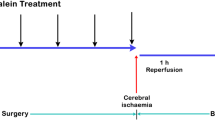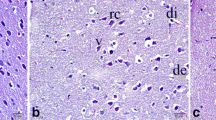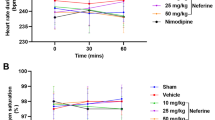Abstract
This investigation was performed to determine the neuroprotective effect of baicalin on permanent cerebral ischemia injury in rats and the potential mechanisms in this process. Adult male Sprague-Dawley rats underwent permanent middle cerebral artery occlusion (pMCAO). The rats were then received intraperitoneal injection with baicalin (10, 30 and 100 mg/kg) or vehicle. Morphological characteristic, neurological deficit scores, cerebral infarct volume and the enzymatic activity of myeloperoxidase (MPO) were measured 24 h after pMCAO. The mRNA expression of inducible nitric oxide synthase (iNOS) and cyclooxygenase-2 (COX-2) were determined by RT-PCR. Neuronal apoptosis was determined by TUNEL staining and Western blot. Baicalin (30 and 100 mg/kg) reduced neurological deficit scores and cerebral infarct volume 24 h after pMCAO. Baicalin significantly decreased the enzymatic activity of MPO and the expression of iNOS mRNA and COX-2 mRNA in rat brain, it also significantly inhibited neuronal apoptosis and the expression of cleaved caspase-3 protein after pMCAO. Our results suggested that baicalin possesses potent anti-inflammatory and anti-apoptotic properties and attenuates cerebral ischemia injury. This protection might be associated with the downregulated expression of iNOS mRNA, COX-2 mRNA, and cleaved caspase-3 protein.






Similar content being viewed by others
References
Durukan A, Tatlisumak T (2007) Acute ischemic stroke: overview of major experimental rodent models, pathophysiology, and therapy of focal cerebral ischemia. Pharmacol Biochem Behav 87:179–197. doi:10.1016/j.pbb.2007.04.015
Lapchak PA, Araujo DM (2007) Advances in ischemic stroke treatment: neuroprotective and combination therapies. Expert Opin Emerg Drugs 12:97–112. doi:10.1517/14728214.12.1.97
Nagahiro S, Uno M, Sato K et al (1998) Pathophysiology and treatment of cerebral ischemia. J Med Invest 45:57–70
Iadecola C, Zhang F, Casey R et al (1997) Delayed reduction of ischemic brain injury and neurological deficits in mice lacking the iNOS gene. J Neurosci 17:9157–9164
Nogawa S, Zhang F, Ross ME et al (1997) Cyclo-oxygenase-2 gene expression in neurons contributes to ischemic brain damage. J Neurosci 17:2746–2755
Nogawa S, Forster C, Zhang F et al (1998) Interaction between inducible nitric oxide synthase and cyclooxygenase-2 after cerebral ischemia. Proc Natl Acad Sci USA 95:10966–10971. doi:10.1073/pnas.95.18.10966
Iadecola C, Zhang F, Xu X (1995) Inhibition of inducible nitric oxide synthase ameliorates cerebral ischemic damage. Am J Physiol Regul Integr Comp Physiol 268:286–292
Candelario-Jalil E, González-Falcón A, García-Cabrera M et al (2004) Wide therapeutic time window for nimesulide neuroprotection in a model of transient focal cerebral ischemia in the rat. Brain Res 1007:98–108. doi:10.1016/j.brainres.2004.01.078
Chop M, Li Y, Jiang N et al (1996) Antibodies against adhesion molecules reduce apoptosis after transient middle cerebral artery occlusion in rat brain. J Cereb Blood Flow Metab 16:578–584. doi:10.1097/00004647-199607000-00007
Hwang JM, Wang CJ, Chou FP et al (2005) Protective effect of baicalin on tert-butyl hydroperoxide-induced rat hepatotoxicity. Arch Toxicol 79:102–109. doi:10.1007/s00204-004-0588-6
Li BQ, Fu T, Gong WH et al (2000) The flavonoid baicalin exhibits anti-inflammatory activity by binding to chemokines. Immunopharmacology 49:295–306. doi:10.1016/S0162-3109(00)00244-7
Jung SH, Kang KD, Ji D et al (2008) The flavonoid baicalin counteracts ischemic and oxidative insults to retinal cells and lipid peroxidation to brain membranes. Neurochem Int 53:325–337. doi:10.1016/j.neuint.2008.09.004
Zhang Z, Wang Z, Zhang X et al (2005) Gene expression profile induced by oral administration of baicalin and gardenin after focal brain ischemia in rats. Acta Pharmacol Sin 26:307–314. doi:10.1111/j.1745-7254.2005.00051.x
Zhang Z, Li P, Wang Z et al (2006) A comparative study on the individual and combined effects of baicalin and jasminoidin on focal cerebral ischemia–reperfusion injury. Brain Res 1123:188–195. doi:10.1016/j.brainres.2006.09.063
Liu P, Wang J, Li Q et al (2006) Effect of baicalin on HSP70 expression of hippocampal neurons in focal brain ischemia-reperfusion injury rats. Yao Xue Xue Bao 41:619–624
Zhang ZJ, Wang LY, Wang Z et al (2006) Pharmacological evaluation of baicalin and jasminoidin and their combination on focal cerebral ischemia-reperfusion injury. Zhongguo Zhong Yao Za Zhi 31:907–910
Li Y, Xu Z, Ford GD et al (2007) Neuroprotection by neuregulin-1 in a rat model of permanent focal cerebral ischemia. Brain Res 1184:277–283. doi:10.1016/j.brainres.2007.09.037
Huang Z, Huang PL, Panahian N et al (1994) Effects of cerebral ischemia in mice deficient in neuronal nitric oxide synthase. Science 265:1883–1885. doi:10.1126/science.7522345
Majid A, He YY, Gidday JM et al (2000) Differences in vulnerability to permanent focal cerebral ischemia among 3 common mouse strains. Stroke 31:2707–2714
Lin TN, He YY, Wu G et al (1993) Effect of brain edema on infarct volume in a focal cerebral ischemia model in rats. Stroke 24:117–121
Swanson RA, Morton MT, Tsao-Wu G et al (1990) A semiautomated method for measuring brain infarct volume. J Cereb Blood Flow Metab 10:290–293
Matsuo Y, Onodera H, Shiga Y et al (1994) Correlation between myeloperoxidase-quantified neutrophil accumulation and ischemic brain injury in the rat: effects of neutrophil depletion. Stroke 25:1469–1475
Lou H, Zhang X, Wei X et al (2004) Anti-inflammatory effect of hydroxyethylpuerarin on focal brain ischemia/reperfusion injury in rats. Chin J Physiol 47:197–201
Fang S, Zhou Y, Chu L et al (2007) Spatio-temporal expression of cysteinyl leukotriene receptor-2 mRNA in rat brain after focal cerebral ischemia. Neurosci Lett 412:78–83. doi:10.1016/j.neulet.2006.10.065
Shang YZ, Miao H, Cheng JJ et al (2006) Effects of amelioration of total flavonoids from stems and leaves of Scutellaria baicalensis Georgi on cognitive deficits, neuronal damage and free radicals disorder induced by cerebral ischemia in rats. Biol Pharm Bull 29:805–810. doi:10.1248/bpb.29.805
Zhang Y, Wang X, Wang X et al (2006) Protective effect of flavonoids from Scutellaria baicalensis Georgi on cerebral ischemia injury. J Ethnopharmacol 108:355–360. doi:10.1016/j.jep.2006.05.022
Gao Z, Huang K, Yang X et al (1999) Free radical scavenging and antioxidant activities of flavonoids extracted from the radix of Scutellaria baicalensis Georgi. Biochim Biophys Acta 1472:643–650
Cho J, Lee HK (2004) Wogonin inhibits ischemic brain injury in a rat model of permanent middle cerebral artery occlusion. Biol Pharm Bull 27:1561–1564. doi:10.1248/bpb.27.1561
Lapchak PA, Maher P, Schubert D et al (2007) Baicalein, an antioxidant 12/15-lipoxygenase inhibitor improves clinical rating scores following multiple infarct embolic strokes. Neuroscience 150:585–591. doi:10.1016/j.neuroscience.2007.09.033
Huang J, Upadhyay UM, Tamargo RJ (2006) Inflammation in stroke and focal cerebral ischemia. Surg Neurol 66:232–245. doi:10.1016/j.surneu.2005.12.028
Perera MN, Ma HK, Arakawa S et al (2006) Inflammation following stroke. J Clin Neurosci 13:1–8. doi:10.1016/j.jocn.2005.07.005
Chou TC, Chang LP, Li CY et al (2003) The antiinflammatory and analgesic effects of baicalin in carrageenan-evoked thermal hyperalgesia. Anesth Analg 97:1724–1729. doi:10.1213/01.ANE.0000087066.71572.3F
Kim DH, Kim HK, Park S et al (2006) Short-term feeding of baicalin inhibits age-associated NF-κB activation. Mech Ageing Dev 127:719–725. doi:10.1016/j.mad.2006.05.002
Kim YA, Lim SY, Rhee SH et al (2006) Resveratrol inhibits inducible nitric oxide synthase and cyclooxygenase-2 expression in beta-amyloid-treated C6 glioma cells. Int J Mol Med 17:1069–1075
Ueda H, Fujita R (2004) Cell death mode switch from necrosis to apoptosis in brain. Biol Pharm Bull 27:950–955. doi:10.1248/bpb.27.950
Yuan J, Lipinski M, Degterev A (2003) Diversity in the mechanisms of neuronal cell death. Neuron 40:401–413. doi:10.1016/S0896-6273(03)00601-9
Lipton P (1999) Ischemic cell death in brain neurons. Physiol Rev 79:1431–1568
Hartmann A, Hunot S, Michel PP et al (2000) Caspase-3: a vulnerability factor and final effector in apoptotic death of dopaminergic neurons in Parkinson’s disease. Proc Natl Acad Sci USA 97:2875–2880. doi:10.1073/pnas.040556597
Chan PH (2004) Mitochondria and neuronal death/survival signaling pathways in cerebral ischemia. Neurochem Res 29:1943–1949. doi:10.1007/s11064-004-6869-x
Namura S, Zhu J, Fink K et al (1998) Activation and cleavage of caspase-3 in apoptosis induced by experimental cerebral ischemia. J Neurosci 18:3659–3668
Acknowledgments
The internal funding from the Department of Neurosurgery, The Affiliated Union Hospital of Fujian Medical University, supported this work.
Author information
Authors and Affiliations
Corresponding author
Rights and permissions
About this article
Cite this article
Tu, Xk., Yang, Wz., Shi, Ss. et al. Neuroprotective Effect of Baicalin in a Rat Model of Permanent Focal Cerebral Ischemia. Neurochem Res 34, 1626–1634 (2009). https://doi.org/10.1007/s11064-009-9953-4
Received:
Accepted:
Published:
Issue Date:
DOI: https://doi.org/10.1007/s11064-009-9953-4




